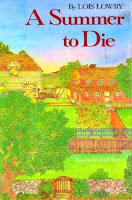Alexie, S. (2007). The Absolutely True Diary of a Part-Time Indian. New York: Little, Brown, and Company. 230 pages, $8.99.
Junior knows he deserves more than what his life on the reservation has given him. Will attending Reardan High School help him attain what he deserves? Will he be able to find a balance between life on the "rez" and life at Reardan? Will he find acceptance in both worlds?
Fourteen-year-old Junior is growing up on the Spokane Indian reservation. Junior is having a hard time on the reservation. Not only does he have medical problems, but he is also picked on by nearly everyone on the "rez". Junior has the love of his family, but he knows that he deserves more even though he's grown up with the notion that things will be the way they are and there's nothing he can do about it. But his math teacher, Mr. P, tells him to go out into the world to make a better life for himself, so with support from his parents, Junior attends Reardan, the all-white school 22 miles away from the rez. It is clear that Junior was unhappy with his life on the rez, but he doesn't try to do anything about it until Mr. P pointed out how much potential Junior's big sister, Mary, had, but she didn't use it to her advantage. After graduating from high school, she stayed in her family's basement. Junior never knew about Mary's potential, and didn't want to end up like her, so he made the decision to transfer schools. This gave Mary the courage to go out and look for something better for herself, so she also leaves the rez and moves to Montana, where she gets married. Junior loses his best friend, Rowdy, when he tells him that he will be attending Reardan. Now he is being treated as a traitor for leaving the rez and thinking he's better than everyone else on the rez and as an outsider by the other students at Reardan. Junior does use his treatment on the reservation to his advantage at Reardan. On the rez, everyone picked on him and beat him up, so Junior has been sticking up for himself his whole life. When Roger, one of the most popular boys on campus, tries to pick on him, Junior, who is known as Arnold at Reardan, punches him, thus earning his respect and that of the other students at Reardan. He slowly starts to fit in at Reardan. He starts dating Penelope, the most popular girl at school, becomes friends with Gordy, a smart boy in his science class, and makes the basketball team. Even though he is doing OK at Reardan, Junior still feels that he's part-time Indian and part-time white. He has trouble feeling comfortable in both places, but despite hardships (deaths in his family, feeling out of place in both places) Junior perseveres and is successful at Reardan, proving that even though he grew up believing that he didn't deserve better than what he has, he can make a better life for himself.
When I first saw the title of this book, I had the idea that it was going to be about someone who is part Indian and part another nationality, so I was a little wrong. It was about a boy who tries to make a better life for himself by attending an all-white school where he is the only Indian on campus. Junior feels like he has two jobs: one is fitting in with his Indian heritage and the other job is filling in with his white school mates. It was nice to see Junior try to make things better for himself even though, in a way, he was going against what his tribe finds acceptable. He showed a tremendous amount of bravery. It was interesting how he used his treatment on the rez helped get him respect at Reardan when he punched Roger. Junior's life did end up better because he earned good grades and he starred on the basketball team. He got what he wanted even though it was tough. It was interesting to learn that this book is based on the life of the author, Sherman Alexie.
This book won the Odyssey Award for the audio version. It is also the winner of the National Book Award. Among other awards, it is also a New York Times Notable Book (2007), a School Library Journal Best Book of the Year, a Kirkus Reviews Best YA book (2007), and a BBYA Top 10 Book for Teens. Visit Sherman Alexie's website, http://www.fallsapart.com/index.html, to find out more about him and other books, stories, and poems he has written. You can look at http://www.ellenforney.com/ to find out more about the illustrator of this book, Ellen Forney.
 |
| Sherman Alexie, author |
 |
| Ellen Forney, illustrator |
 |
| a collection of stories & poems about self-preservation & external responsibility |
 |
| collection of poems |
















